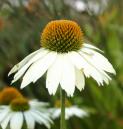Related entry: Copaiba (U. S. P.)—Copaiba
"A volatile oil distilled from copaiba. It should be kept in well-stoppered bottles, in a cool place"—(U. S. P.).
Preparation.—The oil is obtained by distilling copaiba balsam with water. "Take of copaiba, 12 ounces; water, 2 gallons. Distill, preserving the water; when most of the water has passed over, heat, return it into the still, and resume the distillation; repeat this process so long as a sensible quantity of the oil passes over with the water" (Ed.).
Description and Chemical Composition.—The more recent the copaiba balsam, the greater the amount of volatile oil obtained. Usually about 33 to 50 per cent of oil may be distilled from copaiba, and it is stated that one specimen yielded 80 per cent (Amer. Jour. Pharm., Vol. XXII, p. 289). It is inflammable, soluble in ether and sulphide of carbon; its boiling point is 243.3° C. (470° F.); it dissolves caoutchouc; absorbs hydrochloric acid gas, artificial camphor being deposited in crystals. The U. S. P. describes the oil as "a colorless or pale yellowish liquid, having the characteristic odor of copaiba, and an aromatic, bitterish, and pungent taste. Specific gravity, 0.890 to 0.910 at 15° C. (59° F.), increasing with age. Soluble in about ten times its volume of alcohol, forming a slightly turbid liquid, which is neutral to litmus paper"—(U. S. P.). Potassium may be preserved in the oil unchanged. When dropped on iodine, hydriodic acid is produced with sudden development of heat. It dissolves sulphur, iodine, and phosphorus, and is converted into a resinous substance by nitric and sulphuric acids. It has a left-handed optical rotation. It is composed mainly of the hydrocarbon caryophyllene (C15H24). (Compare Oil of Cloves; also see Copaiba.)
Action, Medical Uses, and Dosage.—The oil of copaiba exerts an influence upon the system similar to that of copaiba, to which it is preferred on account of the smaller dose required, and its non-tendency to cause nausea. It enters into many of the nostrums of the day for the cure of gonorrhoea. It is also reputed useful in bronchial catarrh. The dose is 10 or 20 drops, which should be given in syrup, peppermint, or cinnamon water, mucilage, or emulsion.

